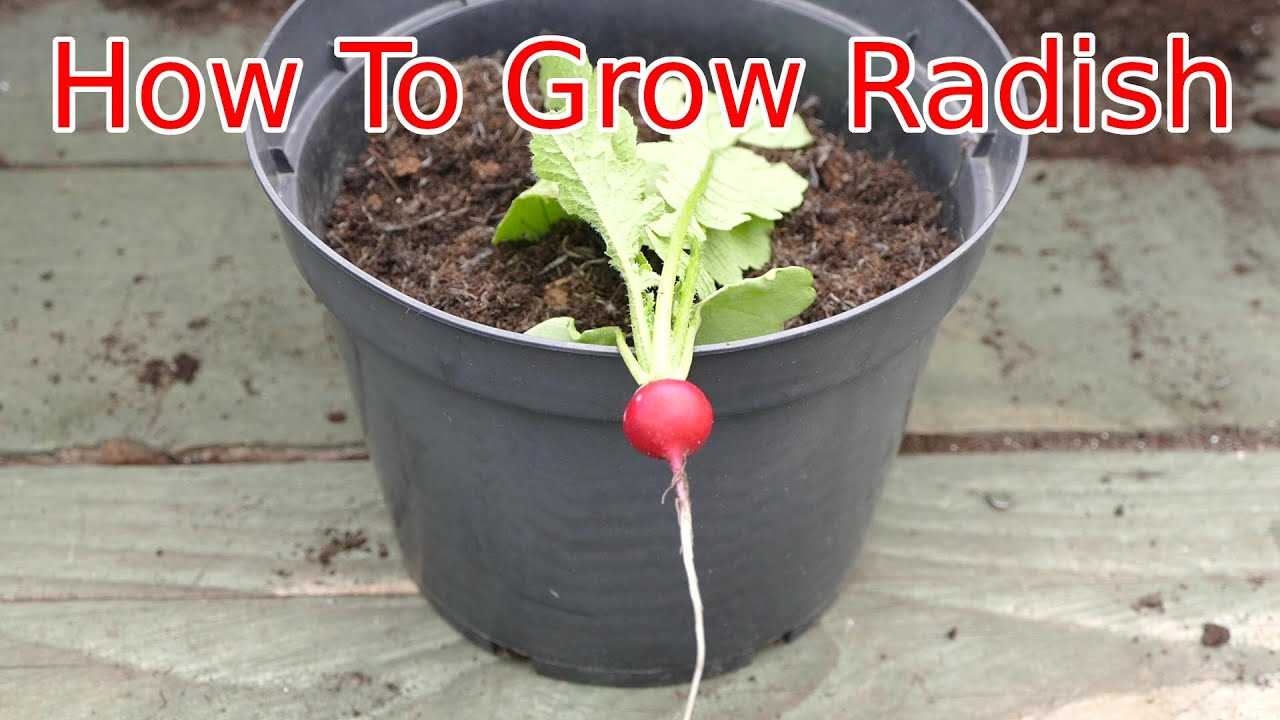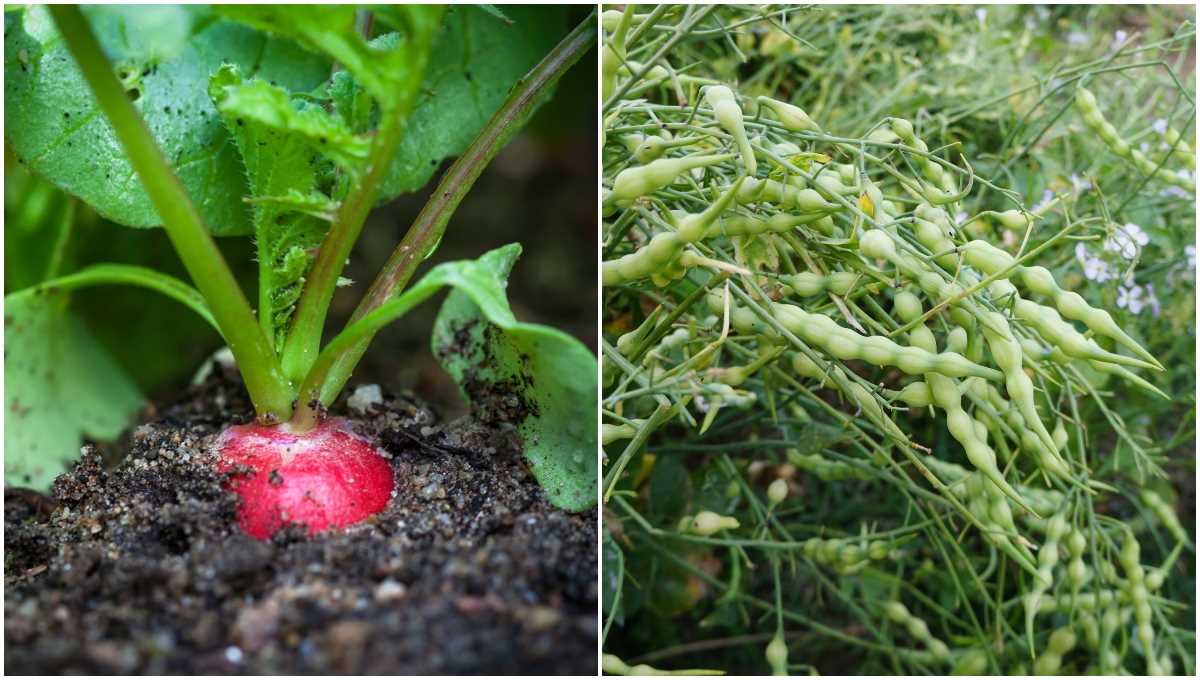- Choosing the Right Radish Varieties
- 1. Early Maturing Varieties
- 2. Winter Varieties
- 3. Round Varieties
- 4. Long Varieties
- 5. Specialty Varieties
- Selecting the Perfect Windowsill for Your Garden
- 1. Sunlight Exposure
- 2. Size and Stability
- 3. Ventilation
- 4. Accessibility
- 5. Temperature and Humidity
- Essential Tools and Supplies
- Preparing the Soil for Your Radishes
- 1. Choose the Right Soil
- 2. Fill Containers or Pots
- 3. Add Organic Matter
- 4. Provide Nutrients
- 5. Mix and Moisturize
- 6. Test the pH
- 7. Loosen and Level
- 8. Time for Seeding
- Planting and Caring for Radish Seeds
- Choosing the right container
- Preparing the soil
- Sowing the seeds
- Watering and sunlight
- Thinning the seedlings
- Providing proper care
- Harvesting
- Pest and disease control
- Conclusion
- Watering and Fertilizing Your Radishes
- Watering:
- Fertilizing:
- Additional Tips:
- Dealing with Common Pests and Diseases
- Pests
- Diseases
- Protecting Your Radish Plants
- Harvesting and Enjoying Homegrown Radishes
- Harvesting:
- Enjoying:
- Storage:
- Q&A:
- Can radishes be grown indoors?
- Do radishes need a lot of sunlight to grow?
- What is the best container size for growing radishes indoors?
- How long does it take for radishes to grow?
- Can radishes be grown all year round indoors?
- Video: 3 Signs That Your Radishes Are Ready to Be Harvested

Do you love the taste of fresh, crispy radishes, but don’t have a backyard garden to grow them in? Look no further! With windowsill gardening, you can enjoy the pleasure of growing your own radishes all year round, right in the comfort of your own home. Whether you’re a seasoned gardener or just starting out, this ultimate guide will provide you with all the information you need to successfully grow and harvest radishes on your windowsill.
Why Radishes?
Radishes are one of the easiest and fastest-growing vegetables to cultivate. They have a distinct peppery flavor and a satisfying crunch, making them a popular addition to salads, sandwiches, and other dishes. Plus, they are packed with nutrients, including vitamin C, fiber, and potassium. By growing your own radishes, you can ensure that you are getting the freshest and most nutrient-rich produce possible.
The Benefits of Windowsill Gardening
Windowsill gardening offers a number of advantages for both beginner and experienced gardeners. First and foremost, it allows you to grow plants indoors, which is particularly beneficial if you don’t have access to a yard or live in an apartment. Additionally, windowsill gardening provides easy access to your plants, making it convenient to care for them and harvest your crops. Plus, it adds a touch of greenery and beauty to your living space, creating a more vibrant and healthy environment.
Getting Started
To get started with windowsill gardening, you’ll need a few basic supplies. These include a sunny windowsill or a grow light, seed trays or pots, potting soil, and of course, radish seeds. Once you have your supplies ready, you’ll need to prepare your seed trays or pots by filling them with potting soil and watering them lightly. Then, simply scatter the radish seeds on top of the soil, cover them with a thin layer of soil, and water them gently. Place your trays or pots on your windowsill or under a grow light, and watch as your radishes begin to sprout in just a few days.
Caring for Your Radishes
Caring for your radishes is relatively easy. They require regular watering to keep the soil moist, but not waterlogged. Avoid overwatering, as this can lead to rotting of the roots. Additionally, make sure your radishes receive plenty of sunlight or artificial light to promote healthy growth. Fertilizing is generally not necessary for radishes, but you can add a small amount of organic fertilizer if desired. Finally, keep an eye out for any pests or diseases that may affect your plants, and take appropriate measures to control them.
Harvesting Your Radishes
Radishes are typically ready to harvest in about 25 to 30 days after planting, depending on the variety. You’ll know that they are ready when the roots have reached their mature size and the tops of the radishes have pushed out of the soil. To harvest, simply grasp the radish at the base, twist gently, and pull it out of the soil. Rinse off any excess dirt, and enjoy your freshly grown radishes however you like!
Windowsill gardening offers a convenient and enjoyable way to grow radishes all year round, regardless of the season or the size of your living space. With a little bit of patience and care, you can enjoy the satisfaction of harvesting your own homegrown radishes and savoring their delicious flavor. So why wait? Get started with windowsill gardening and start growing your own radishes today!
Choosing the Right Radish Varieties
When it comes to growing radishes on your windowsill, choosing the right varieties is important. Different radish varieties have different growth habits, flavors, and textures, so it’s important to consider these factors when selecting which ones to grow.
1. Early Maturing Varieties
Early maturing radish varieties are perfect for windowsill gardening. These varieties reach maturity in as little as 20 to 30 days, which means you can enjoy fresh radishes in no time. Some popular early maturing radish varieties include ‘Cherry Belle’ and ‘French Breakfast.’
2. Winter Varieties
If you’re looking to grow radishes during the colder months, winter varieties are the way to go. These radishes have a longer maturation period, often taking up to 60 days to reach maturity. However, they are more cold-tolerant and can be grown in cooler temperatures. ‘Daikon’ and ‘Black Spanish’ are popular winter radish varieties.
3. Round Varieties
Round radish varieties are the most common and often the easiest to grow. They have a bulbous shape and come in a range of colors, from red to pink to white. Some popular round radish varieties include ‘Easter Egg’ and ‘Scarlet Globe.’
4. Long Varieties
Long radish varieties, also known as daikon radishes, are cylindrical in shape and can grow up to 18 inches long. These radishes have a milder and sweeter flavor compared to the round varieties. ‘Miyashige’ and ‘China Rose’ are popular long radish varieties.
5. Specialty Varieties
If you want to add some unique flavors and colors to your windowsill garden, consider growing specialty radish varieties. These varieties often have a distinct flavor and appearance, making them a fun addition to salads and other dishes. Some popular specialty radish varieties include ‘Watermelon’ and ‘Purple Plum.’
When choosing radish varieties for windowsill gardening, keep in mind the available space, lighting conditions, and your personal preferences. Experimenting with different varieties can add variety and excitement to your indoor gardening experience.
Selecting the Perfect Windowsill for Your Garden
Choosing the right windowsill for your indoor garden is an important step in ensuring the success of your radish cultivation. Here are some factors to consider when selecting the perfect windowsill:
1. Sunlight Exposure
Radishes require at least 6 hours of direct sunlight each day to grow properly. Therefore, it is essential to choose a windowsill that receives the maximum amount of sunlight. South-facing windows are usually the best option, as they receive the most sunlight throughout the day. If you don’t have a suitable south-facing windowsill, east or west-facing windows can also work, but you may need to rotate your plants to ensure even sunlight exposure.
2. Size and Stability
The size and stability of the windowsill are important considerations when setting up your indoor garden. Make sure the windowsill is wide enough to accommodate the number of pots or containers you plan to use. Additionally, check that the windowsill is sturdy enough to support the weight of your gardening materials, such as soil, pots, and plants.
3. Ventilation
Adequate ventilation is essential for the health of your indoor garden. Make sure there is enough airflow around the windowsill to prevent the buildup of excess moisture, which can lead to mold and other plant diseases. If your windowsill doesn’t provide sufficient ventilation, consider using a fan or opening a nearby window to promote air circulation.
4. Accessibility


Consider the accessibility of the windowsill when choosing a location for your garden. You’ll need to regularly water your plants, check for pests, and harvest your radishes. Therefore, it’s important to choose a windowsill that is easily accessible to make these tasks more convenient.
5. Temperature and Humidity
Radishes prefer cooler temperatures, around 50-60°F (10-15°C), for optimal growth. Avoid placing your garden on a windowsill that becomes extremely hot during the day, as this can cause stress to the plants. Additionally, be mindful of the humidity levels around your windowsill. Generally, radishes prefer moderate humidity, so try to avoid excessively dry or moist environments.
By considering these factors and selecting the perfect windowsill for your indoor garden, you’ll be well on your way to successfully growing radishes all year round!
Essential Tools and Supplies
In order to successfully grow radishes on your windowsill all year round, you will need to gather a few essential tools and supplies. Here is a list of the items you will need:
- Seed Starting Mix: This special mix is designed to provide a balanced and nutrient-rich environment for your radish seeds to germinate.
- Radish Seeds: Choose a variety of radish seeds that are suitable for indoor gardening.
- Containers: Select small containers with drainage holes to allow excess water to escape.
- Watering Can or Spray Bottle: A watering can or spray bottle will make it easy to provide your radishes with the necessary moisture.
- Growing Lights: Since radishes require at least 6 hours of sunlight per day, you will need to invest in a set of growing lights to ensure they receive enough light.
- Plant Labels: Use plant labels to keep track of the different varieties of radishes you are growing.
- Plant Fertilizer: While radishes don’t require much fertilizer, a balanced liquid fertilizer can help promote healthy growth.
- Pruning Shears: Pruning shears will come in handy for trimming back any overgrown or damaged radish leaves.
- Waterproof Tray: A waterproof tray will help contain any excess water and prevent it from damaging your windowsill or floor.
Having these tools and supplies on hand will ensure that you have everything you need to start growing radishes on your windowsill. Remember to take care of your plants by providing them with the right amount of light, water, and nutrients, and you’ll soon be enjoying a fresh harvest of radishes all year round!
Preparing the Soil for Your Radishes
Before you start growing radishes indoors on your windowsill, it’s important to prepare the soil to provide the best conditions for your plants to thrive. Proper soil preparation is essential for good growth and high-quality radishes.
1. Choose the Right Soil
The soil you use for growing radishes should be loose, well-draining, and rich in organic matter. A good option is a potting mix or a soilless mix specifically designed for container gardening. These mixes provide the necessary nutrients and drainage for the radishes to grow well.
2. Fill Containers or Pots
Use clean containers or pots with drainage holes to prevent waterlogged soil, which can lead to root rot. Fill the containers with the chosen soil mix, leaving about an inch of space at the top for watering.
3. Add Organic Matter
Enhance the soil’s fertility and structure by adding organic matter, such as compost or well-rotted manure. These materials improve the soil’s ability to retain moisture and nutrients, promoting healthy radish growth.
4. Provide Nutrients
Add a slow-release organic fertilizer to the soil to ensure your radishes have a steady supply of nutrients throughout their growth. Follow the fertilizer’s instructions for the correct amount to use based on the container size.
5. Mix and Moisturize
Thoroughly mix the soil, organic matter, and fertilizer together until they are well-combined. Once mixed, moisten the soil with water until it is evenly damp but not waterlogged. Excessively wet soil can cause root problems and hinder radish growth.
6. Test the pH
Radishes prefer a slightly acidic soil with a pH between 6.0 and 7.0. You can test the soil’s pH using a soil testing kit or pH meter. If the pH is too high, you can lower it by adding elemental sulfur or acidifying agents.
7. Loosen and Level
Before sowing the radish seeds, use a garden fork or hand cultivator to gently loosen and level the soil surface. This helps create a loose and level bed for the seeds, promoting even germination and growth.
8. Time for Seeding
Now that your soil is prepared, you’re ready to sow the radish seeds. Follow the instructions on the seed packet for the correct spacing and planting depth. Gently cover the seeds with a thin layer of soil and lightly press down to ensure good seed-to-soil contact.
By taking the time to prepare the soil properly, you’ll provide your radishes with the optimal growing conditions, resulting in a bountiful harvest of delicious radishes throughout the year.
Planting and Caring for Radish Seeds
Choosing the right container


When growing radishes indoors, it is important to select the right container. A shallow, wide pot or a window box with drainage holes is ideal for radish seeds. Make sure the container is at least 6 inches deep to allow the radish roots to develop properly.
Preparing the soil
Fill the chosen container with well-draining potting soil, leaving about an inch of space at the top. Radishes prefer loose, loamy soil, so you may need to mix in some compost or sand to improve drainage and aeration.
Sowing the seeds
Once the soil is prepared, it’s time to sow the radish seeds. Scatter the seeds over the soil surface, aiming for a spacing of about 1 inch between each seed. Gently press the seeds into the soil, making sure they are covered with a thin layer of soil.
Watering and sunlight
Water the soil thoroughly, making sure it remains evenly moist throughout the germination and growth process. Place the container in a location that receives at least 6-8 hours of sunlight per day. If natural light is not sufficient, you can supplement it with artificial grow lights.
Thinning the seedlings


Once the seedlings emerge and grow a couple of true leaves, it’s time to thin them out. Radishes need room to grow, so leave about 2-3 inches of space between each seedling. Thin them out by carefully pulling out the weaker or extra seedlings.
Providing proper care
Continue to water the radish plants regularly, keeping the soil moist but not waterlogged. Fertilize the plants every 2-3 weeks with a balanced liquid fertilizer to promote healthy growth. Remove any weeds or debris that may interfere with the radish growth.
Harvesting
Radishes are usually ready to be harvested within 20-30 days from sowing. Check the size of the radishes by gently loosening the soil around the base of the plant. When the radishes have reached the desired size, gently pull them out of the soil. Enjoy the fresh, crispy radishes right away or store them in the refrigerator.
Pest and disease control
To prevent common pests like aphids, fleas, or cabbage worms, regularly check the radish plants for any signs of infestation. Use organic pest control methods or insecticidal soap to eliminate pests. Keep an eye out for any signs of diseases such as damping-off, root rot, or leaf spot, and take immediate action to prevent the spread.
Conclusion
By following these simple steps, you can successfully plant and care for radish seeds indoors all year round. Enjoy the convenience of having fresh radishes at your fingertips and the satisfaction of nurturing your own windowsill garden.
Watering and Fertilizing Your Radishes
Proper watering and fertilizing are essential for the successful growth of radishes in a windowsill garden. Here are some tips to ensure your radishes receive adequate moisture and nutrients:
Watering:
- Radishes require consistent moisture to develop properly, so it’s important to keep the soil evenly moist.
- Check the moisture level of the soil by sticking your finger about an inch deep into the soil. If it feels dry, it’s time to water.
- Water your radishes gently to avoid disturbing the soil. Use a watering can with a narrow spout or a spray bottle to control the flow of water.
- Avoid overwatering, as excessively wet soil can lead to root rot. Make sure the water drains well and doesn’t accumulate in the bottom of the container.
Fertilizing:
- Radishes are light feeders and don’t require heavy fertilization. However, providing them with some nutrients can help improve their growth.
- Before planting your radishes, mix some organic compost or well-rotted manure into the soil to enrich it.
- Alternatively, you can use a balanced, water-soluble fertilizer according to the instructions provided on the packaging.
- Be cautious not to over-fertilize, as it can lead to excessive leaf growth rather than proper root development.
Additional Tips:
- It’s important to maintain a consistent watering schedule for your radishes. Check the soil moisture regularly and adjust the frequency of watering as needed.
- Monitor the growth and appearance of your radishes. If they start to develop pale or yellow leaves, it may indicate a nutrient deficiency. Consider applying a foliar fertilizer to address the issue.
- Remember that the size and quality of radishes can also be influenced by the spacing between plants. Provide adequate space for each radish to grow and develop properly.
By following these watering and fertilizing guidelines, you can ensure the healthy growth of your radishes in a windowsill garden. Enjoy the fresh and flavorful radishes all year round!
Dealing with Common Pests and Diseases
Pests
- Aphids: These small, green insects can be a nuisance for radish plants. To control aphids, you can spray the plants with a mixture of water and dish soap or use insecticidal soap.
- Slugs: Slugs can damage the leaves of radish plants. To prevent slug damage, you can create barriers around your plants using copper tape or diatomaceous earth. You can also use beer traps to catch and eliminate slugs.
- Cabbage worms: These green caterpillars can feed on the leaves of radish plants. To control cabbage worms, you can pick them off by hand or use Bacillus thuringiensis (BT), a biological control agent.
Diseases
- Clubroot: Clubroot is a fungal disease that affects the roots of radish plants. To prevent clubroot, you can practice crop rotation and avoid planting radishes in the same area for consecutive years.
- Blackleg: Blackleg is a bacterial disease that causes black lesions on the stem of radish plants. To control blackleg, you should remove and destroy infected plants and practice good sanitation in your garden.
- Downy mildew: Downy mildew is a fungal disease that causes yellow patches on the leaves of radish plants. To prevent downy mildew, you should space your plants properly to allow for good air circulation and avoid overhead watering.
Protecting Your Radish Plants
In addition to dealing with pests and diseases, there are some general practices you can follow to protect your radish plants:
- Monitor your plants regularly: Check your plants for any signs of pests or diseases. Early detection can help you take action before the problem worsens.
- Maintain good hygiene: Keep your gardening tools clean and free from pathogens. Sanitize pots, trays, and growing containers before using them for new plants.
- Provide optimal growing conditions: Radish plants thrive in well-draining soil and require adequate sunlight. Make sure to provide them with the right conditions to promote healthy growth and minimize stress.
- Practice crop rotation: Rotate your radish crops with other vegetables to reduce the risk of soil-borne diseases and nutrient depletion.
By following these tips, you can minimize the impact of pests and diseases on your indoor radish garden and enjoy fresh radishes all year round.
Harvesting and Enjoying Homegrown Radishes
After patiently waiting for your radishes to grow, it’s finally time to harvest them and enjoy the fruits of your labor. Here’s a guide on how to harvest and enjoy your homegrown radishes:
Harvesting:
- Radishes are typically ready to harvest within 3-4 weeks after sowing the seeds. They are best harvested when they have reached their mature size, which is usually around 1 to 2 inches in diameter.
- To harvest radishes, gently loosen the soil around the base of the plant using a small garden fork or your hands.
- Once the soil is loosened, grab the green foliage of the radish and gently pull it out of the ground. The radish should come out easily, with the root attached.
- If you encounter resistance while pulling, use a garden fork to loosen the soil further and try again.
- Some radishes may grow larger than the desired size. If this happens, don’t worry! They are still perfectly edible, although they might be slightly less tender.
Enjoying:


Once you have harvested your radishes, it’s time to enjoy them! Here are some delicious ways to enjoy your homegrown radishes:
- Raw: Radishes are best enjoyed raw for their crisp texture and peppery flavor. Wash them thoroughly, trim off the leaves and root, and enjoy them as a crunchy snack or add them to a salad.
- Pickled: Pickling radishes is a great way to preserve their flavors and enjoy them for a longer time. Slice the radishes and pickle them in a brine made of vinegar, water, salt, and sugar. Let them sit for a few hours or overnight before serving.
- Grilled or roasted: If you want to try something different, grilling or roasting radishes can mellow out their sharp flavor and give them a delicious caramelized taste. Toss them in olive oil, salt, and pepper, and grill or roast them until they are tender.
- Radish greens: Don’t forget about the radish greens! They are edible and packed with nutrients. Use them in salads, stir-fries, or sauté them as a side dish.
Storage:
If you have harvested more radishes than you can eat at once, here are some tips for storing them:
- Remove the greens from the radishes, as they tend to leach moisture from the roots.
- Store the radishes in the refrigerator in a perforated plastic bag or a container lined with damp paper towels. They will last for about a week this way.
- If you have a lot of radishes, you can also preserve them by pickling or freezing them for longer storage.
Now that you know how to harvest and enjoy your homegrown radishes, go ahead and savor the flavors of your hard work and dedication!
Q&A:
Can radishes be grown indoors?
Yes, radishes can be grown indoors, especially on a windowsill where they can receive sufficient sunlight.
Do radishes need a lot of sunlight to grow?
Yes, radishes need at least 6-8 hours of sunlight per day to grow properly.
What is the best container size for growing radishes indoors?
The best container size for growing radishes indoors is around 6-8 inches deep with a diameter of at least 12 inches. This will provide enough space for the radish roots to grow.
How long does it take for radishes to grow?
Radishes typically take about 3-4 weeks to grow, but some varieties can be harvested in as little as 20 days.
Can radishes be grown all year round indoors?
Yes, radishes can be grown all year round indoors as long as they have access to enough sunlight and the right growing conditions.
Video:
3 Signs That Your Radishes Are Ready to Be Harvested







